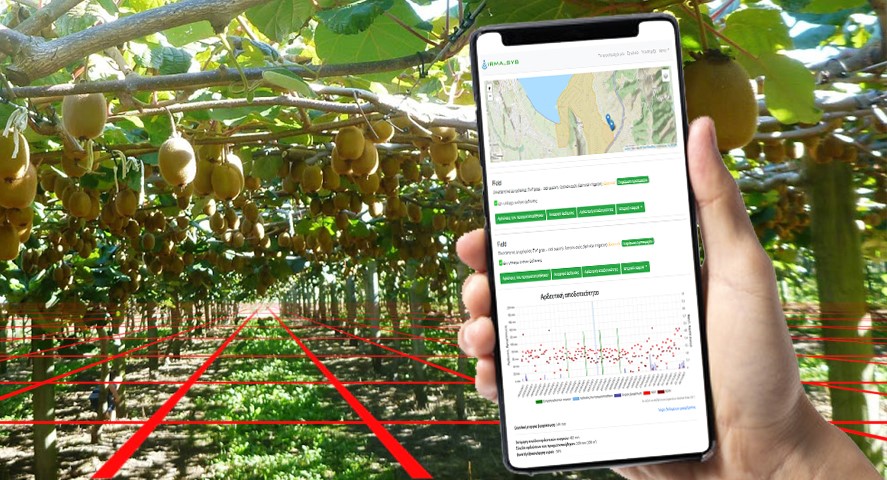Participatory Precision Irrigation Systems – Efficient Management of Irrigation Water

This post is also available in:
This post is also available in:
![]() Ελληνικά (Greek)
Ελληνικά (Greek)
Efficient management of irrigation water with IRMA_SYS
Co-Author:
Angelika Nomikou, Agronomist, R&D collaborator of EFFICIENT WATER RESOURCES MANAGEMENT PC
According to Aquastat (a water-related database of the Food Agriculture Organisation (FAO), in Greece, irrigation (in agriculture) is by far the most significant water user, accounting for over 70% of the total use. In this framework, efficient irrigation water management is very crucial as it can lead to:
- fair management of water as a natural resource
- savings of water, energy, labor, and other inputs like fertilizers, plant protection products, etc.
- reduction of environmental problems like water scarcity, desertification, nitrate pollution, etc
- improvement of agricultural yield in both quantitative and qualitative terms
- improvement of the competitiveness of agricultural products accompanied by documented declarations regarding the application of good water management practices
To support the efficient management of irrigation water, in addition to the required modernization in terms of water conveyance, distribution, and application systems, the effort for optimal irrigation scheduling is particularly important. In this direction, decision support systems aimed at precision irrigation can offer valuable services.
These systems can be classified into two main categories:
- point systems, i.e., those that cover individual farms, often requiring the installation of special sensors to measure various parameters related to weather, soil, etc., and
- participatory systems, i.e., those covering large areas, use data from a limited number of agrometeorological stations and provide information for each agricultural holding within the area covered. Nowadays, systems of both categories commonly use remote sensing data (mainly from satellites) and data from meteorological information services.
Focusing on participatory systems, which are usually installed by organizations related to the management of large irrigation networks or agricultural companies (cooperatives, etc.) that cultivate large areas, it is worth mentioning the pioneer California Irrigation Management Information System (CIMIS), which has been operating since 1982, covering all the agricultural land of the state of California (USA).
Good results with minimum equipment
An example of such a system operating in Greece, covering a cumulative area of 45,000 hectares, is IRMA_SYS. The system is designed to cover large areas and adapt to their particular characteristics. It uses weather parameters from a minimum number of agro-meteorological stations installed in selected points of the area under consideration to cover micro-climatic variations. The agro-meteorological stations supply the system with data regarding temperature and relative air humidity, solar radiation, wind speed, and rain, while through special mathematical models of spatial interpolation, it produces data and weather information for every point inside the covered area. It also uses weather forecast data. Then, taking into account parameters related to the soil, the crop, the irrigation system, and the irrigations that have been performed for each plot, the system applies sophisticated models of evapotranspiration and soil moisture balance based on the relevant standards of the Food Agriculture Organization (FAO – Water).
The result is recommendations for the time and dose of irrigation for each plot and aggregated reports regarding the irrigation water needs for the entire system area. IRMA_SYS does not require the installation of special sensors on the plots for which it offers irrigation recommendations. In any case, using water meters provides valuable data which improves the accuracy of the system’s model.
What is even more interesting is that IRMA_SYS can also be used in the context of educational activities. Learners can create and configure plots in the areas where the system works, monitor recommendations and the fluctuation of soil water balance, and compare and discuss irrigation application options.
As expected for any operational, technological product, IRMA_SYS is systematically evaluated in the field. Sensors measuring water quantity and special sensors measuring air and soil environment are placed in pilot plots. Special attention needs to be paid to using sensors related to soil moisture since the complexity that characterizes the soil can create great problems in monitoring and interpreting the relevant data. In addition to the correct selection of the sensor’s type, quality, and placement location, a sufficient number of sensors per unit area is also needed to ensure reliable results.
A case study of the system in a kiwifruit orchard
The evaluations of IRMA_SYS so far concern maize, alfalfa, cotton, olive, citrus, grape and kiwifruit crops. As an example, the case of kiwifruit is mentioned, a dynamic crop with high water requirements, for which a reduction in the number of irrigations by 20 to 50% and a reduction in water consumption by 35 to 75% have been achieved. The results of the evaluations are either published in peer-reviewed scientific journals or presented at scientific conferences. It is worth noting that FAO mentions IRMA_SYS as a good practice for irrigation water management.
Finally, it is worth emphasizing that participatory decision support systems aimed at precision irrigation provide the possibility to reliably document the real water needs of crops in an area to make productive and socially fair decisions regarding water management. They also facilitate the identification and transfer of good practices.
The installation and operation of participatory decision support systems aimed at precision irrigation can be achieved in a short period of time, quickly leading to multiple benefits.
In any case, it is necessary to understand that such systems can only work effectively with the evaluation and interpretation of the advice by agronomists and their experienced users.








































































